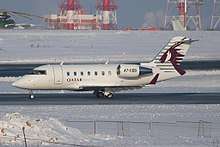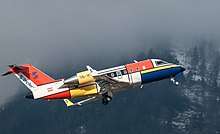Bombardier Challenger 600 series
| Challenger 600/601/604/605/650 | |
|---|---|
.jpg) | |
| A Bombardier CL-604 | |
| Role | Business jet |
| Manufacturer | Bombardier Aerospace |
| First flight | 8 November 1978 |
| Status | In production |
| Produced | 1980–present[1] |
| Number built | 1,066 (Oct 2018)[1] |
| Unit cost | |
| Developed into | CRJ-100/200 Global Express |
The Bombardier Challenger 600 series is a family of business jets. It was first produced by Canadair (as an independent company), and then produced from 1986 by Canadair as a division of Bombardier Aerospace. As of December 2017, close to 1,100 Challenger 600 Series have been delivered.[3] Including the Challenger 300 and Challenger 850, the 1,600 Bombardier Challengers in-service had logged 7.3 million hours and over 4.3 million flights by early 2017.[4]
Development

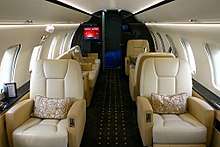
Design process
Circa 1974, Bill Lear conceptualised the LearStar 600 business jet powered by Garrett TFE731-1s. As Lear lacked the capabilities to launch it, Canadair backed it at the end of 1975. Canadair evolved the design to a large airframe with a new supercritical wing, new avionics and engines, for new FAR part 25 standards: an ambitious task. In April 1976, Canadair acquired the 63 by 53.3 ft (19.2 by 16.2 m) long and wide LearStar 600 concept: the most attractive Mach 0.85, 7,240 km (3,910 nmi) range executive jet for 14 passengers, then a freighter for a 3,400 kg (7,500 lbs) payload with a front door, or a less interesting commuter airliner for 30 passengers in 2-1 seating.[5]
The configuration was frozen in August and a 1/25 model was tested in the National Aeronautical Establishment transonic wind tunnel. Backed by the Federal Government, the programme was launched on 29 October 1976 with firm orders and deposits for 53 aircraft. After disagreements, Bill Lear was phased out and in March 1977 it was renamed the Challenger 600. The original conventional tailplane was in the engine exhaust path and it was changed for a T-tail.[5]
The wide cargo door was designed for FedEx, the launch customer with an order for 25. As FedEx had problems with the General Electric CF34s, they favoured the Lycoming ALF 502D but those later had delivery troubles and lacked performance. By 1977 spring, Canadair had over 70 firm orders and began constructing three prototypes. FedEx cancelled its orders due to the US Airline Deregulation Act, and the specific aircraft already in production were sold to other customers.[5]
A full-scale fuselage mockup was shown at the 1977 Paris Air Show before a European and North American tour and 106 had been sold by 1977 end. Airframe structural testing began in February 1979 and operational test cycling started in December 1979, simulating 72,638 flight hours by February 1985 while predicted lifetime was 30,000 hours. By early March 1978, the first prototype was almost finished and the assembly of the two other had debuted. as 116 orders were confirmed 19 months after go-ahead, it was formally rolled out on 25 May 1978, destined to control handling qualities and test flight performance. The flight test and certification program would be conducted at Mojave Kern County Airport instead of Canada due to better conditions.[5]
Flight tests
On 8 November 1978, the prototype aircraft took off from Montreal, Quebec. The second and third prototypes flew in 1979. A test flight on 3 April 1980 in the Mojave Desert resulted in disaster, the aircraft crashing due to the failure of the release mechanism to detach the recovery chute after a deep stall, killing one of the test pilots (the other test pilot and the flight test engineer parachuted to safety).[6]
Despite the crash, both Transport Canada and the Federal Aviation Administration in the United States certified the aircraft in 1980, albeit with restrictions to pilots including a limited maximum takeoff weight. A program to reduce the aircraft's weight was then implemented to improve the aircraft's range.
Bill Lear concept
The name LearStar was not new to this concept, since Bill Lear had long before used the name for his conversion of Lockheed Lodestars into business transports.[7] Canadair's top management was of the opinion that Lear's concept was sketchy at best.[8] Lear did not have an expert grasp of aeronautical engineering. Thus, he had only been able to pay a California aeronautical consultant to do some very preliminary design explorations.[9]
However, Canadair planned to use Lear's name and skills at self-promotion to secure extensive financial guarantees for a business jet project from the Canadian Federal government.[8] This proved an effective choice: future Prime Minister Jean Chrétien specifically refers to the effect of personal contact with Lear on his decision to direct financial support to Canadair's program.[10]
At the time of these events, Chrétien was successively President of the Treasury Board, Minister of Industry, Trade and Commerce, and Minister of Finance, in the Canadian Federal government. Due to the use of letters of comfort, the extent of the Ministry's financial commitments for Canadair could be kept from parliament and the public for several years.[11] These financial guarantees were later used as an academic example of insufficient monitoring and lax controls in government support of industry.[12]
Design
The cabin has a forward galley, two seating sections: typically a four-chair club section then conference grouping or divans and an aft lavatory.[13]
While the Challenger is generally similar in configuration to previous aircraft of its type, some of its features stand out; for example, the use of a widened fuselage that allows a "walk-about cabin". The Challenger was also one of the first bizjets designed with a supercritical wing.
Challengers can be identified visually by their distinctive double slotted hinged flap design, where the fairings can be seen below the wings, a sight much more common on commercial airliners.
Variants
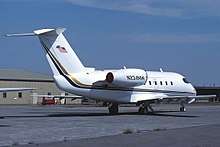
.jpg)
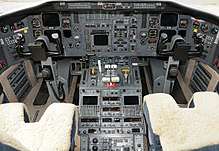
.jpg)
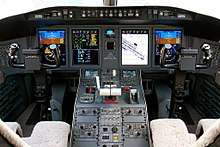
CL-600 (1A11)
- CL-600
- Original production version, powered by Lycoming ALF 502 turbofans of 7500 lbf (33.6 kN) thrust each. Built from 1978 to 1982 (81 built)
- CL-600S
- Three CL-600s retrofitted with the winglets introduced on the CL-601-1A.
- Canadair CC-144
- 12 aircraft purchased by the Royal Canadian Air Force, including the CE-144 and CX-144
- Canadair CE-144
- Three Electronic warfare / EW trainers converted to/from basic CC-144.
- Canadair CX-144
- Second prototype, a CL-600-1A11, c/n 1002, allocated to the RCAF after finishing test programme. Used at the Aerospace Engineering and Test Establishment (AETE), CFB Cold Lake until retirement in 1993, now preserved at the CFB Winnipeg. Designated CC-144 in service.
CL-601
- CL-601-1A (2A12)
- A refined version including winglets to decrease drag and more powerful General Electric CF34-1A (66 built, including six Canadian Forces CC-144B)[14]
- CL-601-1A/ER
- 601-1A retrofitted with an additional fuel tank in the tail
- CL-601-3A (2B16)
- GE CF34-3A engines with a higher flat rating and a glass cockpit. This was the first version marketed by Bombardier.
- CL-601-3A/ER
- 601-3A with an additional, optional fuel tank in the tail
- CL-601-3R
- The tail tank was made standard, CF34-3A1 Engines were introduced.
- CL-601s
- Version powered by GE CF34-3A2 engines[15]
CL-604 (2B16)
- CL-604
- advanced GE CF34-3B engines; increased fuel capacity including saddle tanks in the rear of the aircraft; new undercarriage for a higher takeoff and landing weight; structural improvements to wings and tail; and a new Rockwell Collins ProLine 4 avionics system.
- CL-604 MMA
- (Multi-Mission Aircraft), militarized version, developed by Field Aviation,[16] in Danish service.[16] The aircraft are employed on maritime patrol and search and rescue missions.They are capable of landing on the short, rough, gravel airstrips common in the Arctic.[16]
- C-143A
- A single Challenger 604 aircraft was acquired by the United States Coast Guard in December 2005 as its new Medium Range Command and Control Aircraft (MRC2A).[17]
Built from 1996 through 2006, over 360 were delivered, early ones were selling for $4.0-$4.5 million and late models for less than $8 million in 2016. With 27,000 to 27,100 lb (12,200 to 12,300 kg) BOWs, it carries 6 to 7 passengers and full fuel with the increased MTOW, is able to cruise 7.5-8.0 hr at Mach 0.80 and to fly five passengers 4,000 nm at Mach 0.74 up to FL 410. Thrust lapse as altitude increases, hefty power and wing loadings affects hot-and-high performance: it takes off in 3,500 to 4,000 ft (1,100 to 1,200 m) for under 800 nmi (1,500 km; 920 mi) missions, in 5,684 ft (1,732 m) at MTOW and sea level but in 9,123 ft (2,781 m) at ISA+20C and 5,000 ft (1,500 m) altitudes, and TOW is reduced to 47,535 lb (21,562 kg) to meet climb requirements.
Pro Line 4 avionics include six 7.25 in (18.4 cm) CRTs and dual FMS. It burns 3,800 lb (1,700 kg) in the first hour, 3,200 lb (1,500 kg) in the second hour, 2,800 lb (1,300 kg) in the third hour then 2,000 lb (910 kg)/hr. Scheduled maintenance is done every 200 h or six months and major inspections every 96 months includes $110,000 landing gear overhauls, the 8,729 lbf (38.83 kN) CF34-3B turbofans costs $375 per engine per hour.[13]
CL-605
- CL-605
- Introduced in early 2006, airframe updated with larger cabin windows and a new tailcone, cockpit updated with the Collins Proline 21 avionics and "electronic flight bag" capability.
- CL-605 MSA
- A maritime patrol aircraft design under development by Boeing.[18] Boeing has proposed a repackaging of some of the Boeing P-8 Poseidon sensors but not weapons into a less expensive airframe, the Bombardier Challenger 605 business jet.[19] This aircraft is named Maritime Surveillance Aircraft (MSA) and has been depicted with the AN/APY-10 radar, an electro-optical sensor in a retractable turret, and a magnetic anomaly detector.[20] On February 28, 2014, a MSA demonstrator which is a modified CL-604 made its first flight, but the final aircraft will use the CL-605 airframe.[21][22] The demonstrator currently has the external shapes for the sensors and communications systems which will be added later. The final MSA is expected to cost $55 million to $60 million per aircraft.[23]
The 605 and 650 improve the avionics and cabin but their performance are similar to the 604.[13]
CL-650
Operators
The 500th was rolled out in May 2000.[26] By October 2018, the global fleet amounted to 997: 611 in North America, 151 in Europe, 93 in Latin America, 78 in Asia-Pacific, 37 in Africa and 23 in Middle East.[27]
Military and government operators
%2C_Canada_-_Air_Force_AN0617967.jpg)
.jpg)
- Royal Canadian Air Force: designated as the Bombardier CC-144 Challenger to transport the Governor General, government officials, foreign dignitaries and the Prime Minister of Canada.
- No. 412 Squadron
- No. 434 Squadron (former)
- Croatian Air Force (EMS and VIP Transport)
- German Air Force (seven Challenger 601, retired 2011)
- Korea Coast Guard: operates one CL-604 (B701), outfitted for maritime patrol.[28]
- United States Air Force
- United States Coast Guard: designated as the Bombardier C-143 Medium Range Command and Control Aircraft (MRC2A),[29] provides VIP transport for high-ranking members of the Department of Homeland Security and U.S. Coast Guard using the designation Coast Guard 02
Civilian operators
.jpg)
- LifeFlight Australia: operates one CL604s modified for medevac.
- Cobham Aviation Services Australia: operates four CL604s modified for Search And Rescue (SAR).
- Air Tindi operates two CL-601s
- Government of Quebec: operates two CL601s (one for medevac).
- North Cariboo Air: operates one CL601.
- Shaw Communications: operates 2 CL604s.
- Sunwest Aviation: operates two CL604s.
- Croatian Government: former operator
- Government of the Czech Republic: former operator
- Government Flying Service: operates two CL605s as part of fractional fleet.
- Hornbill Skyways: one CL-605 for state executive flight
- Princely Jets: operates one C604 and one C601-3R
- Qatar Executive: operates three CL605
- Nomad Aviation
- Rega: operates three CL6 for air rescue
- VistaJet Holding SA
- Thai Airways: Former operator
- Turkmenistan Airlines for government VIPs. Operates two CL-605`s[30]
- Dana Executive Jets: operates one CL604
- Jet Exchange Ltd - CL604 / 605, charter flights
- SkyAngels Air Ambulance operates one CL601-3R for air ambulance missions
- West Coast Worldwide operates six CL604s.
- Flex Jet operates a few CL604s and CL605s.
Incidents and accidents
.jpg)
By March 2018, the Challenger fleet suffered 18 hull losses including nine causing 26 fatalities, the worst with 11 fatalities was the latest on 11 March 2018 when TC-TRB, a Challenger 604 crashed near Shahr-e Kord in Iran.[31]
- On October 10, 2000, at 1452 central daylight time, a Canadair Challenger CL-600-2B16 (CL-604) (Canadian registration C-FTBZ and operated by Bombardier Incorporated) was destroyed on impact with terrain and post impact fire during initial climb from runway 19R at Wichita Mid-Continent Airport (ICT), Wichita, Kansas. The flight was operating under the provisions of 14 Code of Federal Regulations (CFR) Part 91 as an experimental test flight. The pilot and flight test engineer were killed. The copilot was seriously injured and died 36 days later.[32]
- A Bombardier Challenger CL-600-2B16 was destroyed on 5 January 2014 after crash-landing at Aspen-Pitkin County Airport in Colorado during a positioning flight from Tucson, Arizona to Salt Lake City, Utah, where a bank which was repossessing the aircraft was to take formal custody. The aircraft attempted a tailwind landing in low-level windshear and gust conditions, then declared a missed approach and executed a go-around. Upon the second landing attempt, the aircraft touched down, bounced airborne again and slammed into the runway, coming to rest upside-down near the departure end, in flames and its right wing separated from the airframe. One crewmember was killed; another crewmember and a passenger sustained serious injuries.[33]
- On January 7, 2017, a Bombardier Challenger CL-604 lost altitude of nearly 9,000 feet as a result of severe wake turbulence from an Airbus A380. Despite substantial damage to the aircraft, the pilots managed to safely land the jet at Muscat International Airport. However, the airplane was written off due to the damage it suffered. All 9 passengers and crew members survived but many of them suffered serious injuries during the incident.[34]
- On March 11, 2018 a Turkish private Bombardier Challenger crashed into Bakhtiari mountains in Iran; all 11 people onboard were killed.[35]
Specifications (Challenger 650)

.jpg)
.jpg)
Data from Bombardier[36]
General characteristics
- Crew: Two (pilot & co-pilot)
- Capacity: Up to 19 passengers
- Payload: 2,200 kg (4,850 lb)
- Length: 20.9 m (68 ft 5 in)
- Wingspan: 19.6 m (64 ft 4 in)
- Height: 6.3 m (20 ft 8 in)
- Wing area: 45.4 m² (489 ft²)
- Aspect ratio: 8.46
- Empty weight: 12,315 kg (27,150 lb)
- Max. takeoff weight: 21,863 kg (48,200 lb)
- Fuel capacity: 9,072 kg (20,000 lb)
- Cabin: 1.83 m / 6 ft 0 in high, 2.41 m / 7 ft 11 in wide
- Powerplant: 2 × General Electric CF34-3B turbofans, 41 kN (9,220 lbf) each
Performance
- Maximum speed: Mach 0.85 (490 kn; 908 km/h)
- Cruise speed: Mach 0.80 (461 kn; 854 km/h)
- Range: 7,408 km (4,000 nm)
- Service ceiling: 12,497 m (41,000 ft)
- Wing loading: 481.6 kg/m² (98.6 lb/ft²)
- Thrust/weight: 0.38
- Takeoff: 1,720 m / 5,640 ft (SL, ISA, MTOW)
- Landing: 732 m / 2,402 ft (SL, ISA, typical)
See also
.jpg)
Related development
Aircraft of comparable role, configuration and era
References
- 1 2 Murdo Morrison (12 Oct 2018). "NBAA: Business jet designs that changed the industry". FlightGlobal.
- ↑ "Business Jets Specification and Performance Data" (PDF). Business & Commercial Aviation. Aviation Week. May 2015.
- ↑ "Bombardier's Newest Challenger Jet Models Surpass Significant Delivery Milestones" (Press release). Bombardier. December 6, 2017.
- ↑ "Bombardier Business Aircraft's Service Centre Network Celebrates Completion of over 200 96-Month Inspections on Challenger Jets" (Press release). Bombardier. 17 Jan 2017.
- 1 2 3 4 5 Bill Upton (2007). "Canadair CL-600 / 601 / 604 Challenger serial 1003, registration C-GCGT" (PDF). Canada aviation museum.
- ↑ "The Crash of Challenger #1001." Check-Six.com. Retrieved: September 19, 2012.
- ↑ Munson, Russell. "Boardroom Bombers: From Warpaint to Pinstripes." Flying, Volume 119, Issue 9, September 1987, p. 96.
- 1 2 Pickler, Ron and Larry Milberry. Canadair: The First 50 Years. Toronto: CANAV Books, 1995. ISBN 0-921022-07-7. p. 263.
- ↑ Logie, Stuart. Winging it: The Making of Canadair's Challenger. Toronto, Ontario: Macmillan Canada. 1992. ISBN 0-77159-145-4, p. 55-57.
- ↑ Low, Stephen. Challenger: An Industrial Romance (16 mm, 57 min 23, sound, colour film). Montreal: The National Film Board of Canada, 1980.
- ↑ Report of the Auditor General of Canada to the House of Commons for the fiscal year ended March 31, 1982, para. 10.95 to 10.100.
- ↑ Borins, Stanford F. and Lee Brown. Investments in Failure. New York: Raven Press, 1987. ISBN 0-458-80340-5.
- 1 2 3 Fred George (Aug 25, 2016). "Used Aircraft Report: Challenger 604". Business & Commercial Aviation. Aviation Week.
- ↑ Walker, R.R. "CC-144 Challenger detailed list." Canadian Military Aircraft Serial Numbers, Canadian Armed Forces, 2006. Retrieved: September 19, 2012.
- ↑ Lombardo, David A. "CF34-3A2 engine ipgrade yields longer time on wing." ainonline.com, August 25, 2010. Retrieved: January 16, 2016.
- 1 2 3 "Update: Denmark's Arctic Assets and Canada's Response — Danish Air Force Aircraft on a Mission over Canada's High Arctic." Archived 2009-07-09 at the Wayback Machine. Canadian American Strategic Review,July 2009. Retrieved: September 19, 2012.
- ↑ Parsch, Andreas. "DOD 4120.15-L - Addendum." designation-systems.net, 2011. Retrieved: September 19, 2012.
- ↑ Hemmerdinger, Jon. "Boeing's Challenger-based maritime surveillance aircraft nears first flight." flightglobal.com, January 10, 2014. Retrieved: January 16, 2016.
- ↑ Gates, Dominic. "Boeing’s cheaper surveillance aircraft takes first flight." Seattle Times (seattletimes.com), March 5, 2014. Retrieved: January 16, 2016.
- ↑ "Maritime Surveillance Aircraft: Boeing selects a Bombardier 'Bizjet', the Challenger 605, as the preferred airframe for its proposed MSA." Archived 2013-09-23 at the Wayback Machine. Canadian American Strategic Review, July 2013. Retrieved: January 16, 2015.
- ↑ "Boeing Selects Bombardier business jet for Maritime Surveillance Aircraft Program." Boeing boeing.mediaroom.com), November 18, 2013. Retrieved: January 16, 2016.
- ↑ "Boeing's MSA demonstrator proves airworthy." Aviation Today (Access Intelligence, LLC.), March 5, 2014. Retrieved: January 16, 2016.
- ↑ Hemmerdinger, Jon. "Field Aviation achieves first flight of Boeing's Maritime Surveillance Aircraft.' flightglobal.com (Reed Business Information), March 5, 2014. Retrieved: January 16, 2016.
- ↑ "Bombardier refreshes Challenger 605 as 650." aviationweek.com. Retrieved: January 16, 2016.
- ↑ "Challenger 650." businessaircraft.bombardier.com. Retrieved: January 16, 2016.
- ↑ "Bombardier rolls out 500th Challenger business jet". Aviation Week Network. Jun 26, 2000.
- ↑ Max Kingsley Jones (4 Oct 2018). "ANALYSIS: Challenger 600 marks 40 years in business". Flightglobal.
- ↑ "Picture of the Canadair CL-600-2B16 Challenger 604 aircraft." airliners.net. Retrieved: October 6, 2012.
- ↑ "History of Air Station Washington." USCG. Retrieved: September 19, 2012.
- ↑ Archived August 22, 2013, at the Wayback Machine.
- ↑ "Canadair Challenger Statistics". Aviation Safety Network. Flight Safety Foundation. 11 Mar 2018.
- ↑ "NTSB Aircraft Accident Brief." Archived 2016-01-08 at the Wayback Machine. aviation-safety.net. Retrieved: January 16, 2016.
- ↑ "NTSB Aircraft Accident Brief." Retrieved: June 12, 2016.
- ↑ Ranter, Harro. "ASN Aircraft accident Canadair CL-600-2B16 Challenger 604 D-AMSC Muscat, Oman". aviation-safety.net. Retrieved 2017-05-18.
- ↑ "Turkish Plane Crashes in Iran". Retrieved March 11, 2018.
- ↑ "Challenger 650 Factsheet". Bombardier. 2017.
External links
| Wikimedia Commons has media related to: |
- Official website
- "CC-144 Challenger". Royal Canadian Air Force.
- "Bombardier Challenger 605". Smartcockpit. Archived from the original on 2016-09-19.
- "Challenger Technical Description & Cutaway". Flight International. 12 August 1978.
- "Canadair Challenger in the air". Flight International. 1 August 1981.
- Mike Gerzanics (21 May 2008). "FLIGHT TEST: Bombardier Challenger 605 - Windows of change". Flightglobal.
